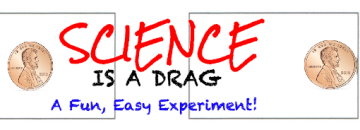Science is a Drag (Aerodynamics)
- Posted on
- By Hema and Eric Bulmer
- Posted in aerodynamics

This experiment is cheap, easy, fast, and effective. Try it & see! READ after the procedure & picture for questions & extension ideas.
Science is a Drag
Air Resistance made EASY!
This experiment is cheap, easy, fast, and effective. Try it & see! READ after the procedure & picture for questions & extension ideas.
Super Short Materials List
- 2 index cards
- 2 pennies
- tape
Procedure
1. LOOK at the picture below. Tape one penny as shown on the card on the left (it's taped to the center of the card) and tape the other penny as shown in the picture on the right (it's taped to the edge of the card).
2. Stand up and hold both cards by an edge out at arm's length so that they're parallel to the floor. It's important to hold both cards at the same height above the floor.
3. Drop both cards at the same time. Watch them fall! Which hits the ground first?

What's Going On?
You probably saw the card with the penny taped to the edge hitting the floor well before the card that had the penny taped to the middle. Taping the penny to the center of the first card causes it to fall without turning - thus, it keeps maximum surface area facing the floor as it falls. All of that surface area is pushing against the air.
The card with the penny taped to the edge tips and falls "head first", presenting an edge (much less surface area) downward, enabling it to cut through the air much faster.
The more surface area of card that has to push through the air, the great the drag of the air against the card. Here's the official science definition of "drag".
Drag (in physics): For a solid object (like an index card) moving through a fluid or gas (like the air), drag is the sum of all the aerodynamic or hydrodynamic forces in the direction of the external fluid flow (like the air pushing against the card). It therefore acts to oppose the motion of the object (the more card area that gets hit by air, the slower it falls).
Extension Ideas
1. Try using nickels instead of pennies.
2. Try using different sizes of index card.
3. Drop two pieces of paper that are equal in size. Then crumple one of them into a ball and drop them again. What changes?
Conversation Starters
1. If you're skydiving, why is just having a parachute not enough? Why must you open it for it to be useful?
2. Why are arrows (like the kind you shoot from a bow) pointed?
3. Why are rocket ships pointy at the top?
4. According to the definition above, Drag occurs in all fluids, not just air. Which would sink faster, a cannonball or a big sheet of metal that weighed the same amount? Why?
© Hema and Eric Bulmer. All rights reserved.
